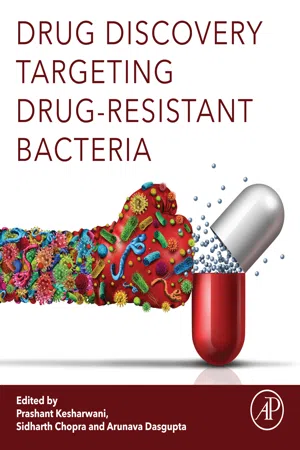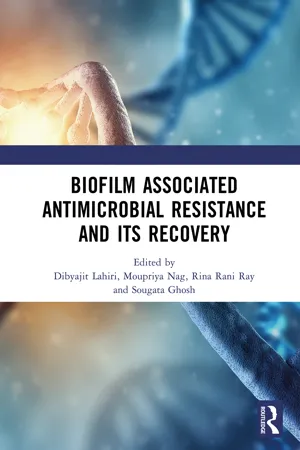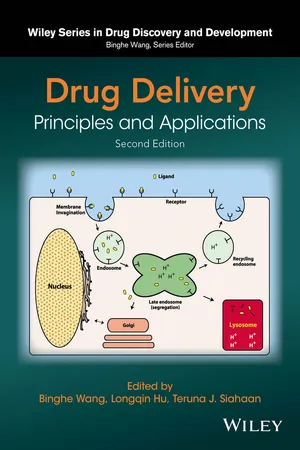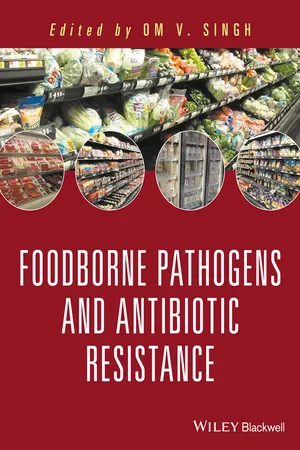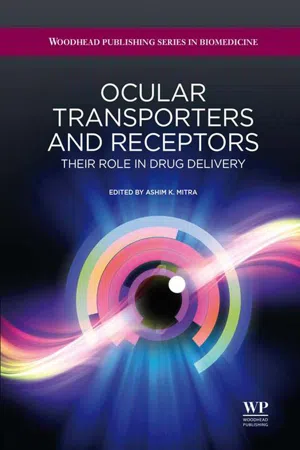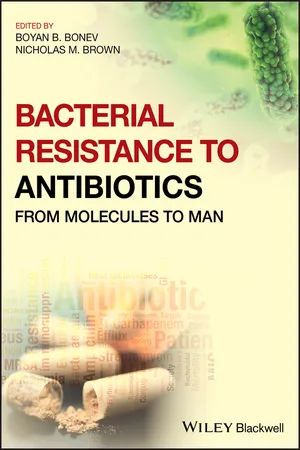Biological Sciences
Efflux Pump
Efflux pumps are protein-based structures found in the cell membranes of bacteria and other organisms. They function to actively pump out toxic substances, including antibiotics and other drugs, from the cell, thereby contributing to antibiotic resistance. Efflux pumps play a crucial role in the defense mechanisms of bacteria and are a significant challenge in the treatment of bacterial infections.
Written by Perlego with AI-assistance
Related key terms
Related key terms
1 of 4
Related key terms
1 of 3
8 Key excerpts on "Efflux Pump"
- eBook - ePub
- Prashant Kesharwani, Sidharth Chopra, Arunava Dasgupta(Authors)
- 2020(Publication Date)
- Academic Press(Publisher)
Chapter 10Importance of Efflux Pumps in subjugating antibiotic resistance
Taru SinghaSajad Ahmad Dara , bShukla DasaShafiul Haqueba Department of Microbiology, University College of Medical Sciences (University of Delhi) and GTB Hospital, Delhi, Indiab Research and Scientific Studies Unit, College of Nursing and Allied Health Sciences, Jazan University, Jazan, Saudi ArabiaAbstract
Antibiotic resistance is defined as a condition that assists any disease-causing organism to resist antibiotics of different class with distinct structure and function directed for its elimination, thereby enabling the survival of the microorganism. Multiple resistance determinants play a major mechanism of bacterial resistance including multidrug Efflux Pumps. Different types of Efflux Pump mechanisms, such as single drug or multidrug-specific, are the significant determinants of resistance, either intrinsic or acquired, to the respective antibiotics. This has resulted in the development of Efflux Pump inhibitors (EPIs). By understanding the working mechanism of the Efflux Pump, various antibacterial agents known as efflux reversals can be described as EPIs, membrane permeabilizers, blockers, energy poisons, etc. Over the last few years a lot of effort was exerted to identify the new and unique EPIs; however, none was found suitable. - Dibyajit Lahiri, Moupriya Nag, Rina Rani Ray, Sougata Ghosh, Dibyajit Lahiri, Moupriya Nag, Rina Rani Ray, Sougata Ghosh(Authors)
- 2023(Publication Date)
- CRC Press(Publisher)
Bacterial Efflux Pumps diligently transport several antibiotics out of the cell and are contributors to the intrinsic resistance of Gram-negative bacteria to many of the drugs that are used to treat Gram-positive bacterial infections. Over expression of Efflux Pumps can also give high resistance to useful antibiotics which were previously effective. They can be specific for a single substrate (Tet pumps) or can transport a wide range of structurally diverse substrates and are known as MDR Efflux Pumps (Piddock, 2006). There are five main superfamilies of Efflux Pumps associated with MDR according to their composition, energy source, number of transmembrane spanning regions and substrates (Figure 5.1): Figure 5.1 Schematics diagram showing the main five superfamilies of Efflux Pumps fund in bacteria and their energy-coupling mechanisms. OM, outer membrane; IM, inner membrane. The multi-drug and toxic compound extrusion (MATE) family: proteins that are predicted to have 12 alpha-helical transmembrane regions (Kuroda and Tsuchiya, 2009), such as MepA. The small multidrug resistance (SMR) family: composed of four transmembrane alpha-helices of approximately 100–140 amino acids in length, for example, Smr (Jack et al., 2001 ; Bay et al., 2017) The major facilitator superfamily (MFS): proteins that transport a broad spectrum of ions and solutes across membranes via facilitated diffusion, symport, or antiport, such as NorA, NorB, NorC, MdeA, SdrM, LmrS (Pao et al., 1998, Yan, 2015) The ATP-binding cassette (ABC) superfamily (Lubelski et al., 2007): transporters that are remarkably conserved in terms of the primary sequence and the organization of the domains or subunits- eBook - ePub
Drug Delivery
Principles and Applications
- Binghe Wang, Longqin Hu, Teruna J. Siahaan(Authors)
- 2016(Publication Date)
- Wiley(Publisher)
5 THE ROLE OF TRANSPORTERS IN DRUG DELIVERY AND EXCRETION Marilyn E. Morris and Xiaowen GuanDepartment of Pharmaceutical Sciences, School of Pharmacy and Pharmaceutical Sciences, University at Buffalo, State University of New York, Buffalo, NY, USA5.1 INTRODUCTION
Therapeutic agents or other xenobiotic compounds can exert their pharmacological or toxicological activities only when sufficient concentrations of the compounds are present at the site of action and upon binding to the targeted receptors or enzymes. Therefore, the ability of drug molecules to cross biological membranes represents an important determinant of drug absorption, distribution, metabolism, elimination, and, ultimately, their therapeutic or toxic effects. It is known that the complex biological membrane system is not pure lipid bilayers, but lipid bilayers embedded with numerous proteins, including transporters. The fundamental role of transporters is to maintain the cellular homeostasis and to provide physiological function for movement of endogenous substances, such as amino acids, glucose, and hormones; however, many of these transporters are also involved in transporting therapeutic agents. Thus, for a large number of drug molecules, their ability to pass through biological membranes is not only solely determined by their physiochemical parameters such as lipophilicity but also governed by drug transporter activities.Drug transporters are classified into two families: the ABC (ATP-binding cassette) and SLC (solute carrier) families. As the name implies, ABC transporters are primary active transporters that utilize ATP as the source of energy. ABC transporters are efflux transporters that transport substrates out of the cell. Members of ABC family that are important in drug excretion include P-glycoprotein (P-gp), multidrug resistance-associated proteins (MRPs), and breast cancer resistant protein (BCRP). In addition, these ABC transporters are also known to transport a number of clinically important anticancer agents, thereby limiting intracellular accumulation of these drugs and resulting in inefficient tumor cell killing, a phenomenon known as multidrug resistance (MDR) that is attributed to overexpression of these transporters on tumor cells [1–4]. In contrast SLC transporter families are secondary active transporters that use the concentration gradient of a cosubstrate such as protons or sodium ions to drive their transport. SLC transporters are mostly influx transporters that transport substrates from the extracellular lumen into the cell; exceptions to this are monocarboxylate transporters (MCTs) 1 and 4 and multidrug and toxin extrusion (MATE) transporters that can function as efflux transporters. - eBook - ePub
- Om V. Singh(Author)
- 2016(Publication Date)
- Wiley-Blackwell(Publisher)
et al., 1999; Pao, Paulsen, and Saier, 1998; Fluman and Bibi, 2009). Therefore, these bacterial multidrug Efflux Pumps require further study.Towards molecular physiological studies of major facilitator superfamily proteins, several key areas are of particular interest. First, study of the structure-function relationships of these transporters will enhance our understanding of their mechanisms for substrate translocation across the membrane, and such molecular structures will make good targets for development of new inhibitors. Mutational analysis and elucidation of additional crystal structures of these multidrug Efflux Pumps may enhance our insight into this important question.Second, it will be important to have a good understanding of the molecular mechanisms responsible for determining the modes of driving energy in a transporter, whether passive or active; and if secondary active transport is operational in a drug transporter, it will be important to understand how the energy stored in the ion gradients generated by respiration are coupled to the transport and accumulation of drug substrate on one or other side of the membrane.Third, it will be necessary to understand the transporter machinery involved in dictating the direction of solute transport, that is, symport versus antiport. Fourth, despite the immense effort directed at comprehending how the Efflux Pumps have such diverse and seemingly extreme substrate promiscuity, it remains a mystery, nonetheless, how the multidrug Efflux Pumps determine substrate number (single drug versus multiple drugs).Fifth, it is further unclear how each of these transporters accomplish their multiple drug specificities. Sixth, it is poorly understood how the Efflux Pumps translocate multiple substrates through a pump while keeping unwanted substrates out. Seventh, we do not know, yet, what determines the ion specificity (proton versus sodium) in the antimicrobial Efflux Pumps of the major facilitator superfamily. Eighth, it will continue to be important to closely study the evolution of the multidrug Efflux Pumps as they move through living populations and influence foodborne infectious disease. Ninth, on a higher plane, it is still unknown to what extent a common molecular mechanism exists for drug transport catalysis, especially considering that these Efflux Pumps collectively harbor such a diverse array of substrates. In short, there remains plenty of work for present and future investigators. - eBook - ePub
Ocular Transporters and Receptors
Their Role in Drug Delivery
- Ashim K Mitra(Author)
- 2013(Publication Date)
- Woodhead Publishing(Publisher)
0’+ ), the organic anion transporting polypeptide family and sodium-dependent multivitamin transporter. In this chapter, the biology of Efflux Pumps and influx transporters with special emphasis on membrane topology, structural conformations, tissue localization and distribution, transport mechanisms, genomic properties and some important mutation sites are discussed in detail.Key words Influx transporters Efflux Pumps biology transmembrane domains membrane topology tissue localization and distribution2.1 Introduction
The integrity of cellular lipid bilayer membranes is critically important for the functioning of the cells. Diffusion of polar molecules across the lipid bilayer is limited, so transporters have evolved to transport vital substances (anions, cations, vitamins, sugars, nucleosides, amino acids, peptides etc.) into the cells and to eliminate toxic materials out of the cells, so maintaining cellular homeostasis. Transporters are membrane/cytosolic proteins that are an integral part of all organisms. These transporters, in humans, play a significant role in the process of drug absorption, distribution, metabolism and elimination (ADME). In essence with their central role of cellular viability, of the 2000 genes in the human genome, about seven of the genes code for transporters or transporter-related proteins [1 ]. There are 400 membrane transporters in two superfamilies and many of these transporters have been identified, cloned and characterized with specific tissue localization profiles [2 ]. From the pharmacological point of view, the transporters are classified into two major superfamilies, i.e. ABC (ATP-binding cassette) and SLC (solute carrier) transporters. ABC transporters act by ATP hydrolysis to actively pump their substrates across the lipid bilayer. These proteins are encoded by 49 genes and are grouped into seven subclasses (ABCA to ABCG) [3 ]. The best documented transporter in the ABC superfamily is the P-glycoprotein (P-gp) encoded by the MDR1 gene and it is responsible for the efflux of several drug molecules. The SLC super family comprises 43 families and contributes to drug absorption [4 ]. There are many well-known SLC transporters including serotonin (SLC6A4 ) and dopamine (SLC6A3 ) transporters. Apart from carrying nutrients or extruding cellular waste/toxins, the broad role of membrane transporters is in drug absorption, distribution and elimination. Further, the role of membrane transporters in drug–drug interactions and multidrug resistance has been well documented. In addition to drug delivery, some of the transporters also serve as a protective barrier for particular organs or cell types. For example, P-gp in the blood–brain barrier or blood–retinal barrier protects the brain and eyes, respectively, from toxic insults by efflux of a variety of structurally diverse compounds. ABC efflux transporters also function in conjunction with drug metabolizing enzymes to eliminate drugs and their metabolites. Molecular cloning of transporter genes delineates the involvement of multiple genes encoding subtypes with similar function with different tissue distribution and specificity towards drugs. Studying these subtypes (e.g. glucose transporters, GLUT 1–4) can unravel the complexities of the structure–activity relationship for drug transport and may allow modulation of transporter activity when needed. Transporters exist in the form of multiple alleles, some of which encode proteins with functional defects resulting in defective drug binding or transport. Although the importance of drug transporters in the process of ADME and drug-drug interactions is well recognized, our knowledge on the biology/physiology of transporters is still emerging. There is a large body of information available in the review published earlier by Sadee et al. [5 - Eric J. Toone, Eric J. Toone(Authors)
- 2011(Publication Date)
- Wiley(Publisher)
Chapter 3 Efflux Pumps of the Resistance–Nodulation–Division Family: A Perspective of their Structure, Function, and Regulation in Gram-Negative Bacteria By Mathew D.Routh Molecular, Cellular and Developmental Biology Interdepartmental Graduate Program, Iowa State University, Ames, Iowa Yaramah Zalucki Chih-Chia Su Department of Microbiology and Immunology, Emory University School of Medicine, Atlanta, Georgia Feng Long Molecular, Cellular and Developmental Biology Interdepartmental Graduate Program, Iowa State University, Ames, Iowa Qijing Zhang Department of Veterinary Microbiology and Preventive Medicine, College of Veterinary Medicine, Iowa State University, Ames, Iowa William M.Shafer Department of Microbiology and Immunology, Emory University School of Medicine, Atlanta, Georgia, and Laboratories of Microbial Pathogenesis, VA Medical Center, Decatur Georgia, and Edward W.Yu Molecular, Cellular and Developmental Biology Interdepartmental Graduate Program, Department of Chemistry, Department of Physics and Astronomy, and Department of Biochemistry, Biophysics and Molecular Biology, Iowa State University, Ames, Iowa I. Introduction With the initial discovery of penicillin and the ensuing mass production of antibiotics in the 1940s, infectious bacteria quickly adapted and developed resistance to the deleterious molecules. In fact, a report published in 1947 found that of 100 Staphylococcus infections tested, 38 were classified as highly resistant to penicillin (1). The initial resistance was associated primarily with individual enzymes inactivating specific antibiotics, such as β-lactamases on penicillin. As novel antibiotics were implemented to combat resistant pathogens, selective pressure led to fundamentally new methods of drug resistance. Currently, there are roughly three major mechanisms utilized by bacteria to evade the toxic effects of biocidal agents- eBook - ePub
Bacterial Resistance to Antibiotics
From Molecules to Man
- Boyan B. Bonev, Nicholas M. Brown, Boyan B. Bonev, Nicholas M. Brown(Authors)
- 2019(Publication Date)
- Wiley-Blackwell(Publisher)
[22] . Their possible roles in resistance to toxic substances cannot be determined until their composition and general structure are known.9.3 Drug Efflux Pumps
Transmembrane (TM ) pump proteins are present and common throughout all kingdoms of life and can be responsible for either active uptake of substances such as nutrients and vitamins, or for active efflux of unwanted (toxic) substances [23] . Of particular interest in the context of MDR are the drug efflux‐pumps, which are grouped into six main families, based upon their phylogenetic connection and correspondingly shared architectures (Figure 9.2 ).General architecture and relative sizes of the principal classes of MDR‐transporters (drawn at the same scale). Where oligomeric state is known, separate protomers have been colored distinctly. ABC‐, MFS‐, and SMR‐families appear to function as dimers, while the RND‐transporter family members form trimeric assemblies. As stoichiometry of PACE‐ and MATE‐transporters hasn't been conclusively established, they are shown as monomers. The position of the inner membrane (IM ) is relative.Figure 9.29.3.1 ABC Transporters
Of these protein families, just one generates the energy required for substrate translocation directly – namely by hydrolysis of ATP. The members possess a signature ATP‐recognition sequence motif and are thus nominatedATP‐binding cassette(ABC ) transporters. ABC transporters are a varied group, and only a few have been directly implicated in multidrug efflux, e.g., the ABC transporters of the MacB‐family, which form part of a macrolide Efflux Pump. In common with the majority of ABC transporters, the MacB‐like transporters are dimeric [24] , with each protomer providing half of the ATP‐binding site. However, and in contrast to the canonical ABC transporters, which have extensive TM domains of 5 to 10 helices per protomer, each monomer of MacB has just four TM helices [25] . Also in contrast to the rest of the ABC transporters, its cytoplasmic nucleotide binding domain is located N‐terminally [26] , and the protein has a prominent mixed α/β periplasmic domain, which shares structural similarity with the RND‐transporter family [27] . The periplasmic domain interacts with partner proteins, while the nucleotide binding domain binds and hydrolyses nucleotides, primarily ATP [24 , 28 ]. While the direct data on cargo binding of MacB is missing, it is likely that, similar to other better‐studied members of the ABC‐family such as MsbA and the P‐glycoprotein, the TM helices of both subunits form a clam‐like arrangement to bind the substrate in the inner leaflet of the membrane and, following ATP‐hydrolysis, undergo a conformational change to release it on the outer side [29] - eBook - ePub
Oral Bioavailability and Drug Delivery
From Basics to Advanced Concepts and Applications
- Ming Hu, Xiaoling Li(Authors)
- 2024(Publication Date)
- Wiley(Publisher)
22 ABC Transporters in Intestinal and Liver EffluxMarilyn E. Morris and Tianjing RenUniversity at Buffalo (State University of New York), School of Pharmacy and Pharmaceutical Sciences, Department of Pharmaceutical Sciences, Buffalo, NY, USA22.1 Introduction
The oral bioavailability of many drugs depends on their ability to cross intestinal membranes and avoid first-pass extraction either due to metabolism or efflux transporters. A lipophilic drug can cross membranes by passive diffusion, while hydrophilic drugs require active transport processes to enter cells. Whether a drug is lipophilic or hydrophilic, it can be extruded out of cells by a class of transporters known as the ATP binding cassette (ABC ) family of transporters. These transporters play a pivotal role in protecting tissues such as brain, testis, and placenta, among others, from xenobiotics. The ABC superfamily of transporters consists of 51 human genes in 7 subfamilies [1] , but not all transporters are involved in drug transport. The ABC transporters involved in drug transport are found in many tissues in the body including the liver, kidney, brain, and intestine. The liver and the intestine are the tissues most important in the oral bioavailability of drugs. The efflux transporters linked with drug transport in the liver and the intestine are ABCB1 (MDR1), ABCB4 (MDR2/3), ABCB11 (BSEP), ABCC1-6 (MRP1-6), and ABCG2 (BCRP).The absorption of most nutrients and drugs occurs in the small intestine. Some efflux transporters are opportunistically located on the apical membrane of enterocytes that line the gut lumen (Figure 22.1 ). These transporters are responsible for the efflux of a wide range of substrates from enterocytes back into intestinal lumen, limiting the oral bioavailability of these compounds. The compounds that escape efflux in the small intestine enter the liver through the portal vein, where they can undergo hepatic first-pass extraction by metabolism and/or excretion into bile. Efflux transporters located on the canalicular membrane in hepatocytes facilitate the efflux of compounds against their concentration gradient into bile (Figure 22.2
Index pages curate the most relevant extracts from our library of academic textbooks. They’ve been created using an in-house natural language model (NLM), each adding context and meaning to key research topics.
Explore more topic indexes
Explore more topic indexes
1 of 6
Explore more topic indexes
1 of 4
